All About the Stone of Scone and Coronation Chair That King Charles Will Be Crowned On
- Oops!Something went wrong.Please try again later.
King Charles will be crowned in a chair that's been a part of royal tradition for more than 700 years
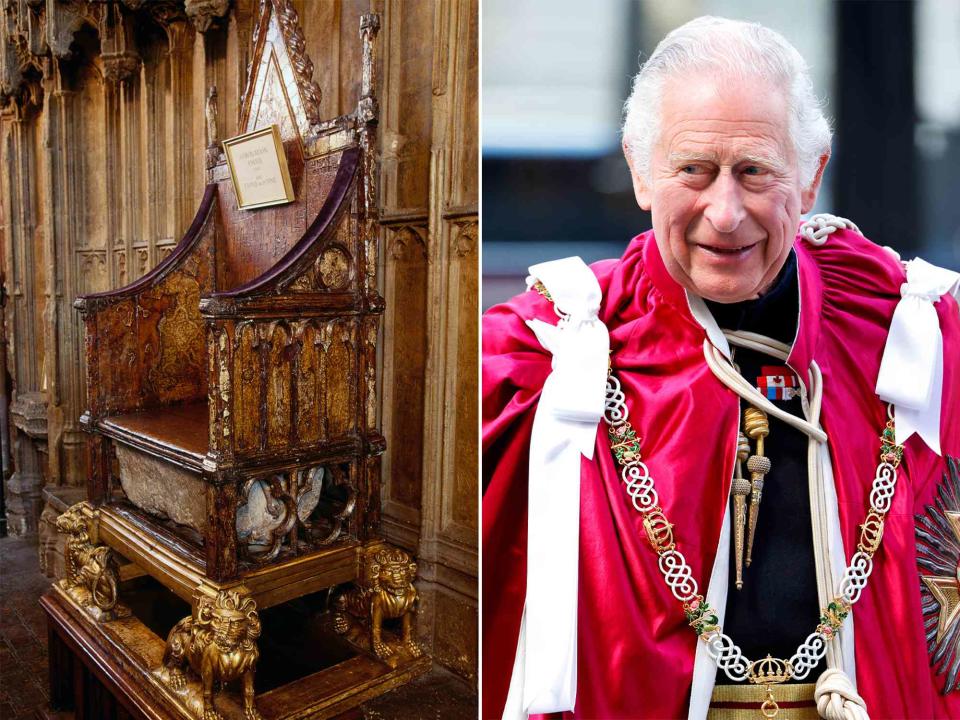
When King Charles is officially crowned during his coronation ceremony on May 6, he will be seated upon centuries of British history.
For over 700 years, the Coronation Chair has been integral to marking the beginning of a new monarch's reign, providing a centerpiece for the crowning of royals like Henry VIII, Elizabeth I and Charles' mother, Queen Elizabeth II.
When the chair was originally commissioned by King Edward I in the early 1300s, its primary purpose was to house the monarch's newly acquired Stone of Scone (pronounced "skoon"). The 300-pound rock had previously been in Scotland's possession, whose monarchy had used it as a throne for hundreds of years — though some legends date it as far back as Biblical times.
The Coronation Chair and the Stone of Scone were kept together for hundreds of years — and endured several traumas, including a bombing and robbery — until the stone was returned to Scotland in 1996.
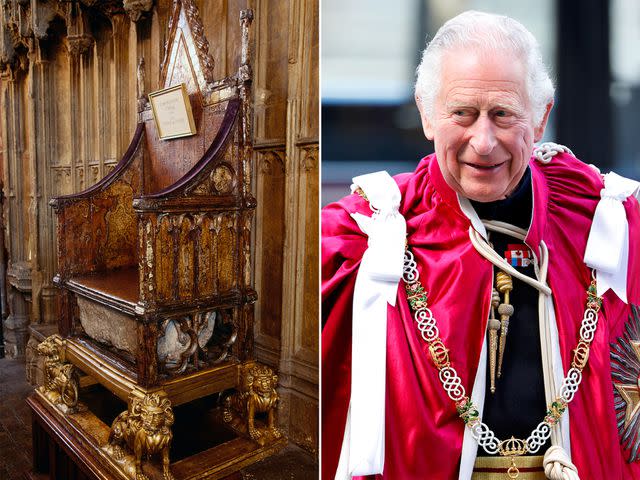
Currently, the Coronation Chair is undergoing significant conservation work ahead of King Charles' crowning, where it will be reunited with the Stone of Scone for the ceremony. Because the stone is now kept in Scotland, it was transported to Westminster Abbey for the coronation.
In addition to the Coronation Chair, several other ceremonial chairs of historical significance, including the Chairs of Estate, Throne Chairs and some of the Congregation Chairs, will be used for the crowning. According to a press release from Buckingham Palace, King Charles and Queen Camilla will sit in the Chairs of Estate for the early parts of the service and the Queen Consort's coronation before moving to the Throne Chairs for the Enthroning and the Homage.
Ahead of King Charles' May 6 coronation, here's everything to know about the Stone of Scone and Coronation Chair on which he will be crowned.
What is the Stone of Scone?
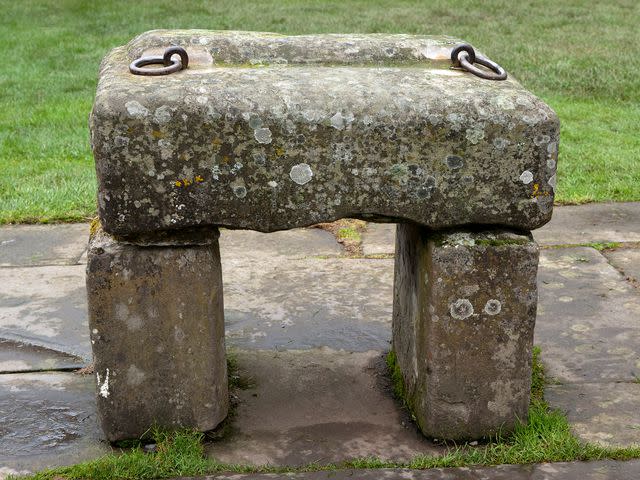
The Stone of Scone, also known as the Stone of Destiny or the Coronation Stone, is a slab of sandstone that holds special historical significance to both England and Scotland. For centuries, the stone was fit into the base of the Coronation Chair, on which English monarchs have been crowned during coronation ceremonies. Weighing in at over 300 pounds, the stone measures 26 inches by 16 inches by 10 inches, according to Encyclopædia Britannica.
On April 29, 2023, the Stone of Scone arrived at Westminster Abbey from the Crown Room at Edinburgh Castle in Scotland. It's arrival was celebrated with a special service conducted by the Dean of Westminster, the Very Reverend Dr. David Hoyle.
What is the history of the Stone of Scone?
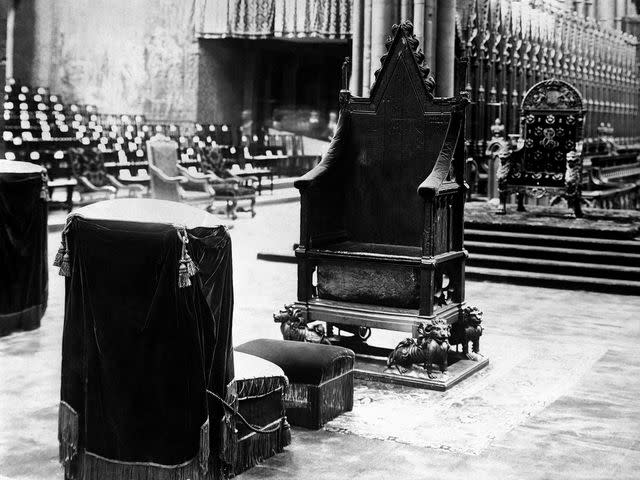
The exact origins of the Stone of Scone are unknown, but there are numerous theories and legends of the stone's history. Some believe that the stone was originally used as a pillow by the Biblical figure Jacob. As accounted in the Book of Genesis, while Jacob rested on a group of stones, he received a vision from God, who promised Jacob the land on which he laid — this would eventually become the city of Bethel.
Scottish historian William Forbes Skene suggested in his 1869 essay "The Coronation Stone" that the stone traveled across what is now Europe with various groups. It was eventually brought from Ireland to Argyll, Scotland, by Fergus, the first king of the Scots. Fergus is believed to have been crowned on the stone around 500 A.D. — though this is a topic of debate among historians.
While the legend of the Stone of Scone traveling across continents was widely believed for many years, geologists who have studied the stone have disproven many of the surrounding beliefs. According to Historic Environment Scotland, a public research institution based in Edinburgh, Scotland, the stone underwent a technical examination in 1998.
Geologists determined the composition to be that of sandstone typically found in the Perthshire area of Scotland. The stone most likely belonged to the Picts before they were conquered around 843 by Kenneth I, who is considered the founder of Scotland. Kenneth moved the stone to the town of Scone, Scotland, from which it later received its name. Although the stone currently used is from Scotland, some believe that a more ancient stone exists and was hidden during wartime, per the BBC.
Regardless of the stone's exact origins, historians agree that the relic was used in coronation ceremonies for hundreds of years. But during the First Scottish War of Independence in 1296, the stone was taken by King Edward I of England after he invaded the country amid political tensions. Although some question if Edward I stole the authentic Stone of Scone, the relic he captured was brought to Westminster Abbey, where it was placed in a specially made chair.
In 1328, a peace treaty signed by England and Scotland promised that the stone would be returned — but it remained in London for another six centuries, during which English monarchs sat upon the stone during the coronation ceremonies.
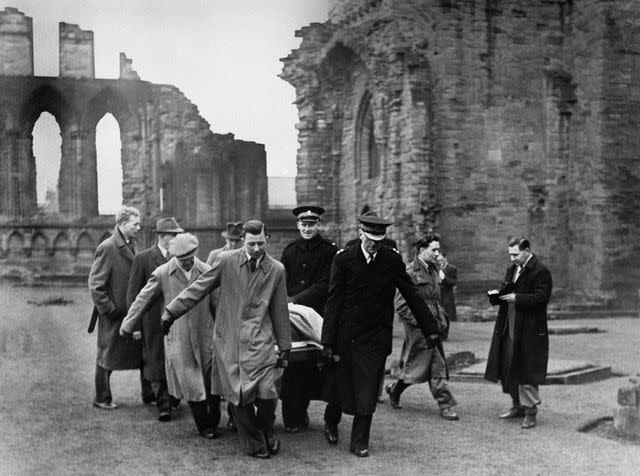
In 1924, Scottish politician David Kirkwood brought a bill to parliament proposing the stone's return, but it was ultimately turned down. Then in 1950, a group of Scottish students broke into Westminster Abbey and successfully stole the stone. They drove the relic back to Scotland, where it was briefly on display at Arbroath Abbey. British police ultimately returned the stone to England. The group was charged, but not prosecuted, with criminal activity.
In July 1996, around 700 years after the stone was originally stolen, Prime Minister John Major announced that it would finally be returned to Scotland. The announcement came as a surprise to many. On Nov. 15, 1996, the stone was officially handed over at the border between England and Scotland, per CNN.
For King Charles' coronation, the stone will temporarily return to England, where it will be placed in the Coronation Chair.
What is the Coronation Chair?
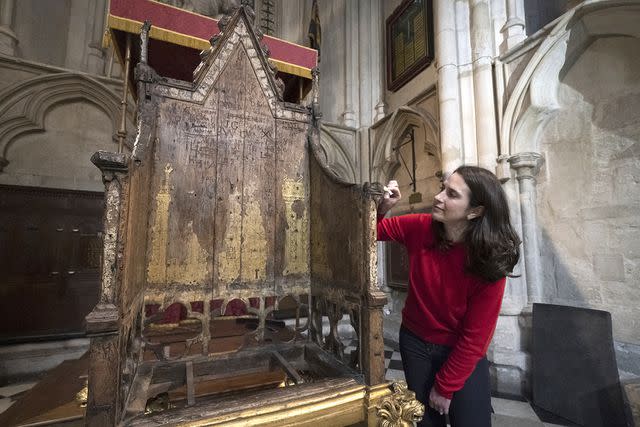
Also known as St. Edward's Chair or King Edward's Chair, the Coronation Chair is the ancient throne on which British monarchs are crowned at their coronation. The piece was first commissioned by King Edward I around 1300; after seizing the Stone of Scone from Scotland, the monarch needed a home for his conquest, and tasked carpenter Walter of Durham with the job.
Constructed out of oak, the chair was covered in gold leaf to appear as if it were made of solid gold. It was also intricately decorated with colored glass and painted with patterns of birds and foliage. A figure of Edward I with a lion at his feet was also painted on the back, though it has long since faded. In the early 16th century, gilded lions were placed on each corner at the base of the chair, though the base was later replaced during the 18th century.
Though it was not originally designed to be a Coronation Chair, the piece was first used in the coronation of Henry IV in 1399 and became part of the ceremony from then on. Originally, the Stone of Scone was placed uncovered at the base of the chair, and monarchs sat on the stone itself until a platform was added during the 17th century.
Over the years, the chair has gone through several renovations. "It has suffered occasionally over its lifetime, there is graffiti on the back from local schoolboys and visitors carving their names in the 18th and 19th centuries, and a bomb attack in 1914 knocked a small corner off it," a Westminster Abbey official said in a March 2023 release. The chair also lost its primary function — housing the Stone of Scone — when the stone was returned to Scotland in 1996.
However, the stone and the Coronation Chair will be reunited for King Charles' coronation; the chair is currently being cleaned and stabilized by Westminster Abbey conservator Krista Blessley in preparation.
Which other royal coronations used the Stone of Scone?
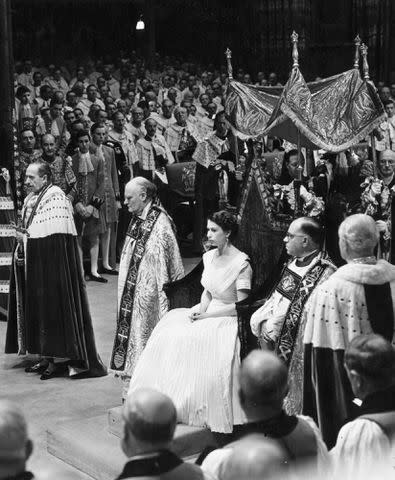
Before the English acquired the Stone of Scone, it was used for centuries by Scottish rulers. It is said to have been used at the coronation of Fergus, the first king of the Scots, but according to The Stone of Destiny: Symbol of Nationhood, it wasn't until 574 A.D. that there was recorded evidence of the inauguration of a king. According to the Scottish government, the stone became part of the written record in 1057, when it was used to crown Lulach at Scone Abbey.
After the stone was brought to England, it was used during the coronations of British monarchs, including Queen Elizabeth's crowning in 1953.
Where are the Stone of Scone and Coronation Chair kept?
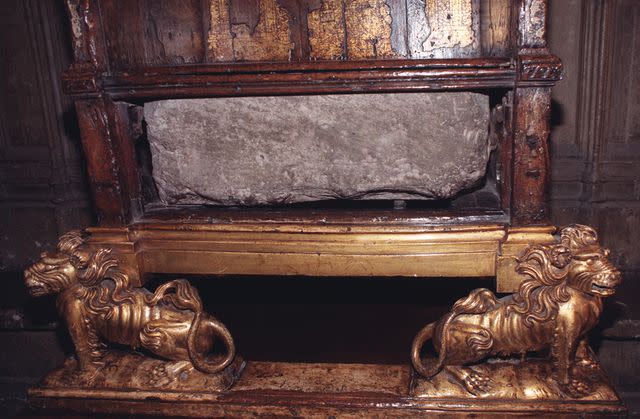
When the Stone of Scone was first given back to Scotland in 1996, it was displayed in the Crown Room of Edinburgh Castle, where the public could view it for a fee. In 2019, the Scottish Government opened a discussion with the public as to whether the stone should remain at Edinburgh Castle or be featured in a new museum in Perth, Scotland. In December 2020, Scotland's First Minister Nicola Sturgeon announced that the stone would be transferred to the Perth Museum, which is set to open in the spring of 2024.
As for the Coronation Chair, the piece is kept behind glass at St. George's Chapel, located in the Abbey's Nave. Since its creation, the chair has only been removed from Westminster Abbey twice — once for a ceremony in 1653 and once out of security concerns during World War II.
For more People news, make sure to sign up for our newsletter!
Read the original article on People.

